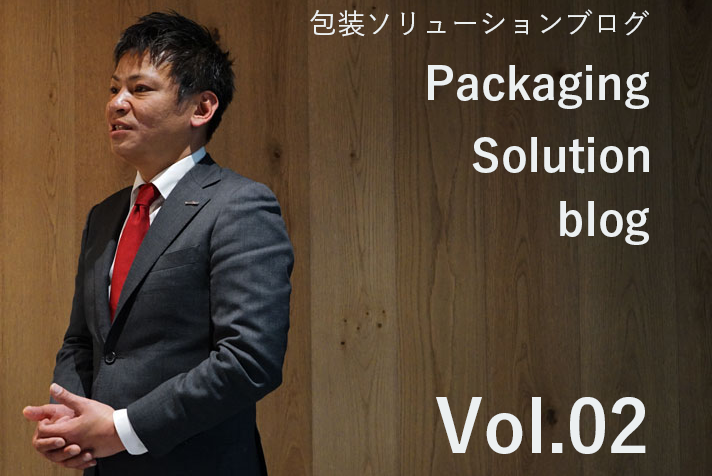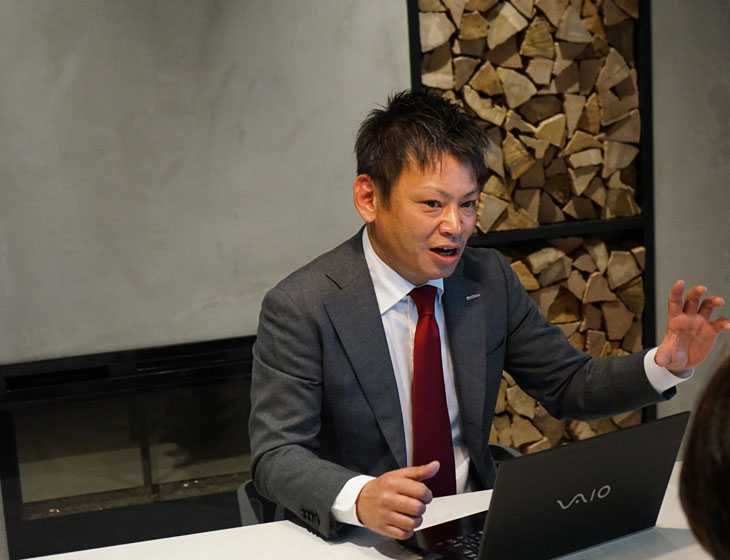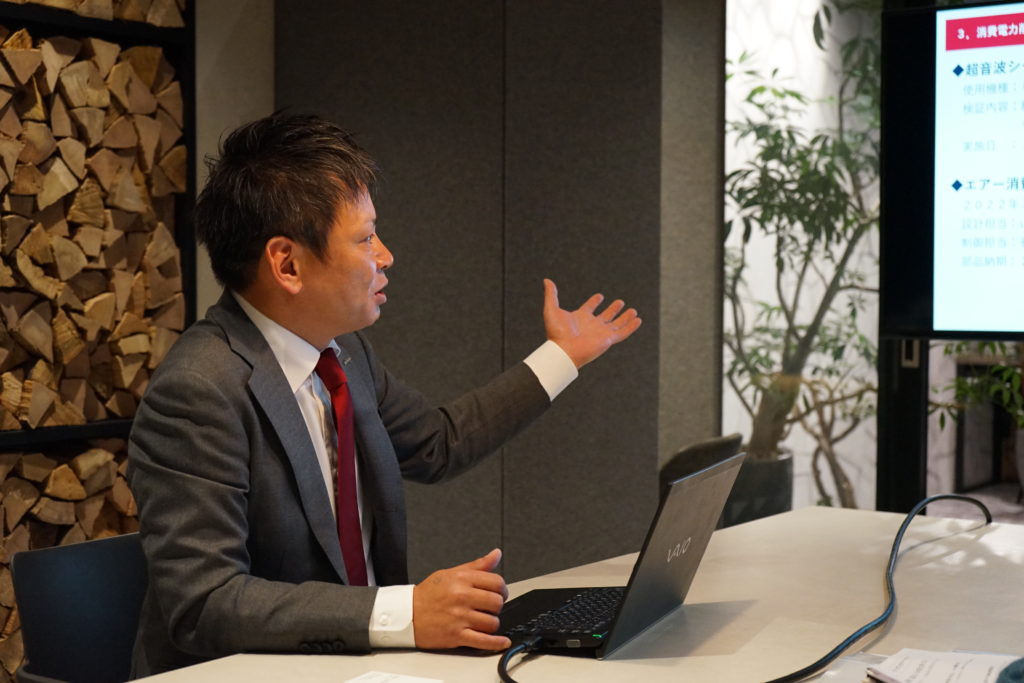
The latest efforts in environmentally friendly packaging materials and the ability of advanced packaging materials to enhance product branding
-
- Category:
- COLUMN
-
- Date:
- May.2.2024
Interview with Kenkichi Abe, General manager, Solution Strategy Department at Kawashima Packaging Machinery Ltd.
Measures for SDGs/carbon neutrality and the future led by the latest environmental technology
Changes in consumer awareness and the market environment are now spreading across the world as a major trend. Environmental awareness of the public has grown rapidly over the past few years, resulting in SDGs as the fruition. Corporate management is under great pressure from external factors, such as rising energy costs and a competitive environment that makes it difficult to differentiate. How can we continue to grow sustainably in this era of dramatic change?
Kenkichi Abe, head of the Packaging Solutions Strategy Office, will talk about the response of Kawashima Packaging Machinery Ltd. to SDGs and carbon neutrality, the progress of the latest environmental technology, and the innovative packaging technology that will lead the future and solve the challenges faced by food manufacturing sites.
 Kenkichi Abe, General manager, Solution Strategy Department at Kawashima Packaging Machinery Ltd.
Kenkichi Abe, General manager, Solution Strategy Department at Kawashima Packaging Machinery Ltd.
The latest efforts in environmentally friendly packaging materials and the ability of advanced packaging materials to enhance product branding
The road to plastic-free
>The spread of SDGs has become to affect packaging materials used to package food. Efforts to change the straws, spoons, and forks used in takeout of restaurants and convenience stores to paper or wooden materials from plastic have been increasingly featured in the news. There is also a trend to move away from plastics in packaging materials.
Abe: Some of you may remember the news that in 2020, Starbucks Coffee switched to paper straws for iced drinks at all of its stores in Japan. Major convenience store companies are also gradually phasing out plastic straws and switching to biodegradable materials and paper straws. The Act on Promotion of Plastic Resource Recycling (New Plastics Act), enacted in April 2022, aims to reduce plastic waste and strengthen recycling. The target is to reduce plastic waste, and companies are accelerating their efforts to eliminate and reduce plastic use. Similarly, a wave of change is coming to the packaging materials used to package food. Until now, most of the packaging materials used in packaging machines were made of plastic. Plastic has the property of stretching when pulled, and can be easily changed in shape or bonded together by heat, making it a material that is very compatible with machines. Because of its high airtightness, it was perfect for food packaging. However, from the perspective of SDGs, we must reduce the use of petroleum-derived plastic products in the future. Food packaging is no exception. We need to change packaging materials from petroleum-based plastics to other materials. Therefore, plant-based materials such as paper and bioplastics are currently under attention.
>The first thing that comes to mind as a representative material that is not derived from petroleum is paper, but what kind of material is bioplastic?
Abe: Bioplastics are materials made from biological resources. It can be produced from sugarcane, corn, potato starch, etc. Sugarcane is the raw material for sugar, and plastic can be made from the excessive honey produced during the process of making sugar. When you hear the word “plant-based,” you get the image of a material that decomposes naturally, but not all bioplastics are biodegradable, meaning that they can be broken down by microorganisms in the soil. There are two types of bioplastics: biodegradable ones and non-biodegradable ones that are derived from plants but do not break down naturally.
>In recent years, the issue of small pieces of discarded plastic polluting the ocean has become a hot topic, and the calls for “elimination and reduction of plastic”’ are becoming louder than ever. It seems that there are many fields in which biodegradable bioplastics can be used in the future.
Abe: That’s right. However, there are many challenges. Most biodegradable bioplastics are broken down by microorganisms in the soil, so if they are thrown into the ocean, they may end up floating in the ocean without being decomposed. However, if we were to replace all current plastics with biodegradable ones, it is still a problem to bury that large amount of plastic. Furthermore, biodegradable plastic is much weaker than conventional plastic, and is also sensitive to heat. Normally, heat is often used when gluing bags together, but when doing so, the sheet melts and sticks to the machine, making itself very difficult for packaging machines to handle. On the other hand, non-biodegradable biomass plastics have almost the same appearance and properties as petroleum-based plastic materials, so they are easier to handle for packaging machines.
>What are the benefits of changing to non-biodegradable biomass plastics?
Abe: Even though it is derived from plants, it cannot decompose naturally in nature, and thus contributes insignificantly to the reduction of ocean pollution, which is currently well-concerned. However, it can still contribute to “carbon neutrality.” In the case of non-biodegradable plastics, whether derived from petroleum or plants, the process of waste disposal is done by burning them, and carbon dioxide, a typical greenhouse gas, is emitted at the same time. However, in the case of plant-based materials, the plants that serve as the raw materials absorbed carbon dioxide during the growth process. If the amount of carbon dioxide released when the plant-based materials are burned is the same as the amount of carbon dioxide absorbed during the plants’ growth process, no new emissions are generated. The amount of carbon dioxide emitted is considered to be “zero”. This is the concept of “carbon neutral”.
> Even non-biodegradable biomass plastics are environmentally friendly in that they contribute to reducing carbon dioxide emissions.
Abe: The problem here is that the new raw materials are not produced enough to replace all conventional plastics. Currently, most of this material is used for the plastic bags used in supermarkets and convenience stores, and it is difficult to obtain it as a packaging material. In addition, it is difficult to distinguish it from conventional plastic through appearance, so it does not have the impact of “changing to a plant-based material.” Because it is easier to appeal to consumers, store managers and buyers who come into direct contact with end users tend to prefer paper materials. Paper alone gives the impression of being “environmentally friendly”.

From plastic to paper – the latest packaging machine that overcomes the differences in material properties
>If plastic packaging is changed to paper, it instantly shows that the product is environmentally friendly. In fact, if you consciously look around, you would notice that more and more paper materials such as bags of sweets etc. are increasing.
Abe: In 2019, Nestlé changed its Kit Kat packaging to paper, and it seems that the industry has started to shift from plastic to paper. However, it is technically very difficult to use paper as a packaging material for packaging machines. This is because plastics have the property of elasticity when stretched, but paper does not extend when stretched. On the contrary, it will be torn apart.
Therefore, in the past, plastic could be pulled with strength, but with paper, it is necessary to pull with subtle force. Another problem is that it is vulnerable to piercing from above. For example, in a vertical pillow machine where food is packed in a bag-like packaging material from above and then sealed inside, the packaging material may be punctured or torn by the impact of dropping the food from above. Another major difference between plastic and paper materials is stiffness. In the case of vertical pillow packaging machines, food is placed from above and the top edge is glued. At this moment, if the food does not reach the bottom and stops halfway, the food will be crushed by the machine when the top of the bag is glued. To prevent this, the latest vertical pillow packaging machines have a mechanism in which the bag is slightly bent to widen the gusset, allowing food placed from the top to sink to the bottom. However, paper is less elastic than plastic materials, so it will not bend naturally even if you try to bend it in the same way as for plastic. After much trial and error, we were able to bend the bag by opening the mouth and pressing it, allowing the food to sink to the bottom. This is a patented manufacturing method invented by Kawashima Packaging Machinery Ltd.
>This method was created because the paper has a strong stiffness. I have heard that paper packaging is not airtight and is not suitable for preserving food.
Abe: Paper packaging lacks airtightness and has weak light-blocking effects, so if you want to make it last longer, you need to take precautions. Various manufacturers of packaging materials are researching ways to compensate for paper’s weaknesses. Currently, paper alone lacks various properties such as water resistance, oil resistance, and barrier properties, so we add other functional materials into paper. For example, some products such as paper cups and paper plates have smooth surfaces. It is made by pasting a thin layer of plastic material onto paper to prevent water from passing through. However, when paper is coated in this way, it is difficult to separate the paper from the coating, making it difficult to recycle. From the perspective of carbon offset, it is sufficient to simply change from plastic to paper material. However, we can take one step further by developing a more functional “glue” that can be separated from the paper material and make it ultimately recyclable.
>Paper is also less strong than plastic.
Abe: If you put things in from the top, the bottom may be torn, so we currently cover the paper with a film to prevent holes from forming. In the case of paper materials, if 50% or more of the material is made of paper, the recycling paper mark can be attached. However, this requires an increased usage of the overall amount of paper, which creates another problem: the paper packaging becomes thicker. Although there are already packaging machines that can handle punctures without applying such a film, it is necessary to run those machines at a slower pace than the previous model. I believe that further improvements are needed so that machines that can prevent holes can also move at the same pace as the previous model.
The future of recyclable packaging materials
>I heard that in addition to plant-based materials such as paper and bioplastics, “mono- materials” (single materials) are attracting attention from the perspective of SDGs.
Abe: Currently, the films used to pack food are made up of four to five layers that have various functions, such as adhesive materials, light blocking materials, and heat-resistant materials. Each layer has a different function and is combined to make a single film. This film, with various functions, consists of different materials to achieve respective functions. Unfortunately, it is impossible to separate each material when disposing of the film. To recycle, items made of different materials must be collected separately, so currently used packaging made up of different materials with different functions, cannot be recycled. The reason why recycling of milk cartons, plastic bottles, etc. is progressing now is that they are mono-materials (single material).
>I heard that there are two types of plastic materials that can be used as mono-materials: polypropylene (PP) and polyethylene (PE).
Abe: PET bottles are made from PE alone, so they can be recycled. However, both PP and PE are transparent and allow light to pass through easily, so when used for food packaging, it is necessary to devise ways to prevent light from passing through in order to prevent the contents from deteriorating. Also, if it is to be used as a packaging material, the material must have sealing properties. However, both PP and PE are sensitive to heat, and like biodegradable plastics, when heated with a heater, areas other than the adhesive area are also heated, making them sticky and easily stuck to the packaging machine. As a solution, we are currently researching whether ultrasonic waves are effective for sealing. The Plastic Resource Recycling Promotion Act (New Plastic Act) also includes a milestone of “reusing and recycling 60% of containers and packaging by 2030.” Therefore, it is thought that the desire to use packaging materials made of mono-materials that are easy to reuse and recycle will increase in the future.
Currently, recycling mainly refers to plastic bottles, bottles, cans, milk cartons, etc., but as the national policy has been set to promote reuse and recycling, in the near future, infrastructure facilities for collecting and recycling used packaging material made of mono-materials are also likely to be in place.
Therefore, the transition to mono-materials is beginning to take place. As for measures to eliminate and reduce plastics, the possibilities of new packaging materials that can be reused and recycled, such as bioplastics, paper, and mono-materials, are becoming available. Each has advantages and disadvantages, and various approaches to handle them are being taken at the same time, so it is unknown whether all of them will be utilized in the future, or whether some of them will be weeded out and concentrated into paper and mono-materials. Kawashima Packaging Machinery Ltd. takes the advantages and disadvantages of each material into consideration and is currently developing packaging machines that are compatible with all kinds of packaging materials. We promise that in the near future, we will bring to the world a packaging machine that can solve some of the problems we are currently facing.
(To be continued)




